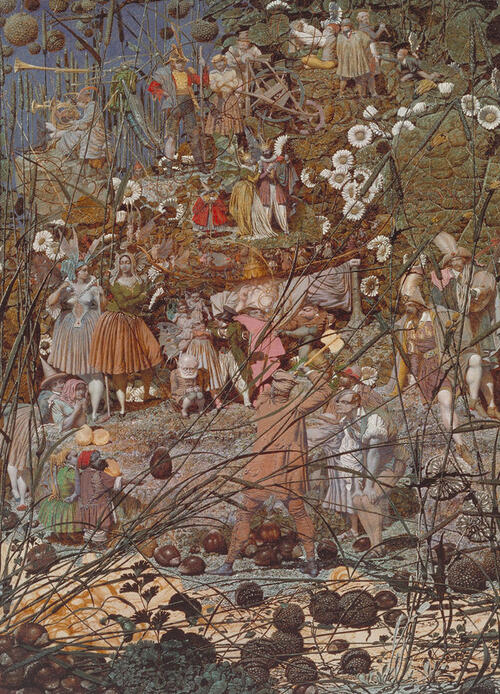
The Fairy Feller's Master-Stroke by Richard Dadd
Schizophrenia is that disease that everyone associates with “hearing voices.” There is actually a lot more to it than that. In addition to hallucinations, people with schizophrenia might have delusions (such as paranoia or believing they are a famous person). Disorganized speech, catatonic depression, and flat emotions are a few other fun symptoms. However, it’s the “voices” that people always think of. While plenty of people find it frightening, schizophrenia is a condition that people can manage and live with. Creating art is one tool that can help some people make sense of the world, even if they live out their entire lives in a mental hospital.
1. Richard Dadd
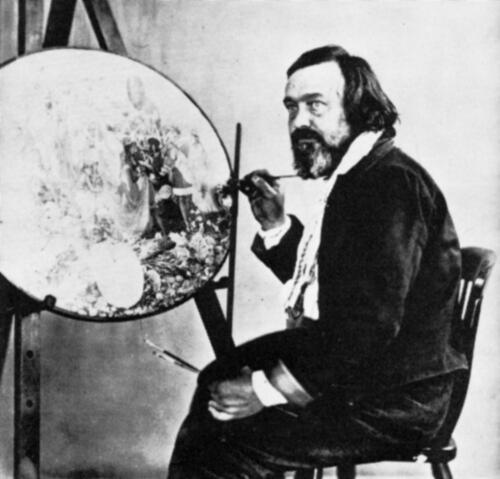
In his mid-twenties, Richard Dadd took a trip that precipitated a lifetime journey of mental illness. During the ten-month expedition, he grew increasingly angry with others, began to have delusions, and threatened to murder the Pope. When he returned, the delusions overtook him; his behavior changed, his diet got weird, and people had difficulty understanding what he was trying to say. A doctor diagnosed him with “an aberration of the intellect” and recommended psychiatric care, but his father declined.
That was a mistake; during a nice walk in the park, Dadd stabbed his father to death. He spent the next four decades of his life in Britain’s two most notorious psychiatric prisons. His mental health continued to decline, and he suffered from delusions for his entire life. He was diagnosed with homicidal monomania due to emotional trauma; now we know it was paranoid schizophrenia.
Nevertheless, he devoted time to his art. In fact, he spent nine years adding paint to Fairy Feller, a painting which is so thick on the canvas that it became three-dimensional. During his lifetime there simply were no anti-psychotic medications and maybe nobody knew how to help him in a way to make it safe for him to be back out on the streets. However, he’s an example of someone who can keep giving back through art.
2. Camille Claudel
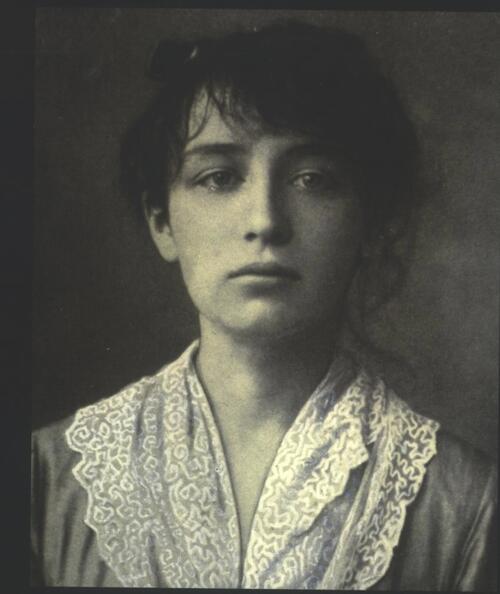
Claudel was a major contributor to the works of Rodin. She could have been a significant artist in her own right. However, in a period of schizophrenic distress, she destroyed many of her original works. Mental illness often emerges when nature and nurture collide. Camille likely had the genetic traits that made her prone to schizophrenia, but it only blew up after a series of events. Specifically, her torrid affair with the much-older Rodin ended badly, triggering dormant emotions from childhood, and causing her descent. It didn’t help that she had one or more abortions, the emotional aftermath of which were never treated.
She began to accuse Rodin of stealing her work (which might not have been too off base). She spent most of her life in an asylum, although friends questioned whether she truly needed to be there. Schizophrenia isn’t a death sentence; people can live fulfilling lives despite the diagnosis. However, her care was handled poorly. Her family rejected her; her mother and sister never visited, and the staff was asked not to even send them the letters she wrote. She died in the asylum at age 78. Just imagine what more she could have offered to the world had her care been more compassionate and creative.
3. Louis Wain
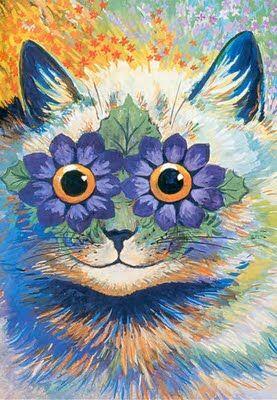
Flower Eyes by Louis Wain made an appearance in BoJack Horseman, Season 5
Schizophrenia doesn’t manifest right away. It takes time to develop into a full-blown condition. Louis Wain seemed to do fine for a time and was even successful as an artist. However, his mental health deteriorated, and he ended up penniless. Although schizophrenia doesn’t always (or even often) lead to violence, Wain was a violent man. Eventually, his erratic behavior landed him in one mental hospital after another. In fact, it was in Napsbury Hospital where there were a bunch of cats in a garden, that Wain stabilized enough to create some of his best works of art.
4. Agnes Martin
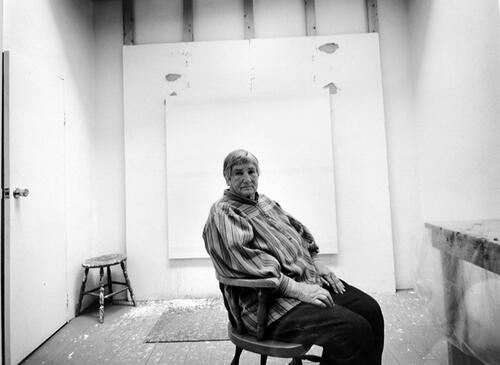
Agnes Martin managed to live her entire life, to the age of 92, without revealing her diagnosis to very many people. However, after her death in 2004, more information came to light. She didn’t like to think of her illness as having anything to do with her art. However, others have said that her minimalism is a reflection of an attempt to give order to her mental chaos.
5. Yayoi Kusama
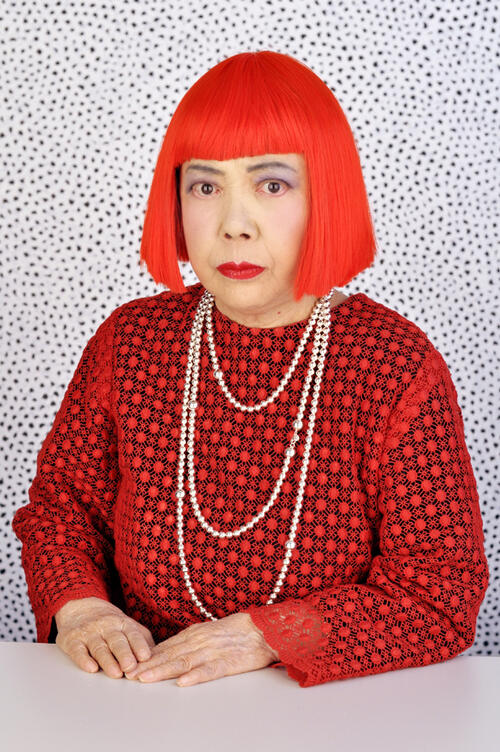
Yayoi Kusama is one of the world’s best-known female artists. She’s also an 89-year-old woman who has been living in a mental hospital for more than forty years. She says that art is what saved her life.
Truth be told, her diagnosis probably isn’t schizophrenia. However, in the 1950’s, a psychiatry professor presented a paper on her that described her as having “schizophrenic tendency”. Basically, she has visions and hallucinations that overwhelm her. However, it’s the anxiety that she finds really debilitating. She describes how before she checked herself into the asylum, she was painting nets everywhere, and the nets came alive and gripped her, and she had a panic attack because she felt that she could not escape them, and she writes, “anxiety felt like flame flickering in my bones”.
So, her given diagnosis is probably anxiety. Occasionally, it’s been labeled OCD, which helps explain why she puts those signature dots on everything so precisely. But she has had hallucinations, and although it was many years ago, there was that suspicion of schizophrenia.
This post is part of our ongoing series on Mental Health in Art History.
Sources
- “Richard Dadd.” Living with Schizophrenia. Accessed October 14, 2018 https://www.livingwithschizophreniauk.org/richard-dadd/
- Deese, Patrick. “Richard Dadd.” Popsubculture(dot)com’s The biography Project. Accessed October 14, 2018, https://www.popsubculture.com/pop/bio_project/richard_dadd.html
- Milton, Joseph. “How a Mental Disorder Opened Up an Invisible World of Colour and Pattern.” Scientific American. Dec. 22, 2011. Accessed October 14, 2018 https://blogs.scientificamerican.com/creatology/how-a-mental-disorder-o…
- Miranda, Carolina. “What the world misunderstands about artist Agnes Martin and how her biographer unearthed her story.” LA Times. Apr. 12, 2016. Accessed October 14, 2018, http://www.latimes.com/entertainment/arts/miranda/la-et-cam-agnes-marti…
- Lamberg, Lynne. “Artist describes how art saved her life.” Psychiatric News. Sep. 14, 2017. Accessed October 14, 2018 https://psychnews.psychiatryonline.org/doi/full/10.1176/appi.pn.2017.9a…
- Kusama, Yayoi. “Infinity Net: The Autobiography of Yayoi Kusama.” Tate. 2013.
Comments (5)

We should bring back mental health hospitals. Reagan ruined everything.
Unfortunately, my husband was also diagnosed with schizophrenia and the doctor told us that his case is too advanced. I wish he had an outlet like art.

To feel trapped is a horrible sensation; how horrifying to feel CONSTANTLY surrounded and trapped by nets 😳
Thank you for shining a light on these artists who, while fighting for their lives, enrich our own.
(And I never knew of Wain’s proximity to his subjects. Yay cats!)

I studied Yayoi and Agnes in a MOMA course I did a couple of years ago. LOVE these two ladies and their work.
I did my best to give my interpretation of their works as part of the course and gained an even bigger appreciation of their work and lives.










I think having an artistic outlet is so healthy for people with these types of disorders.